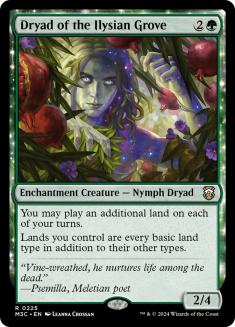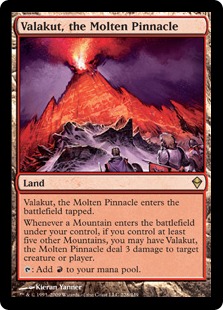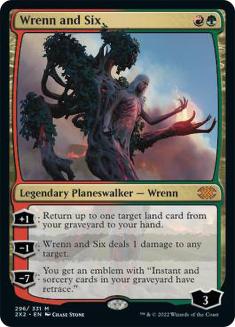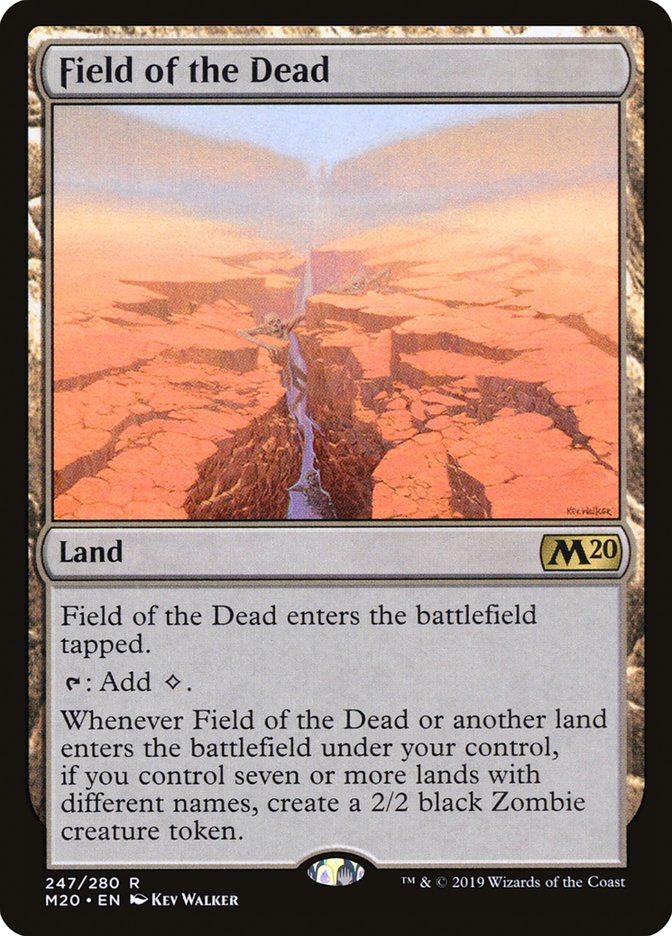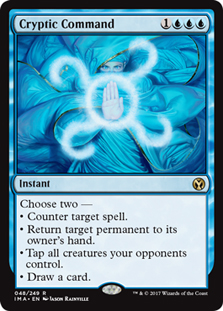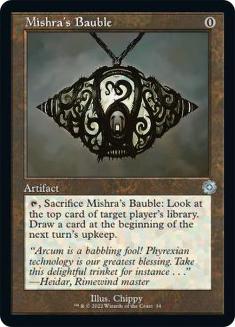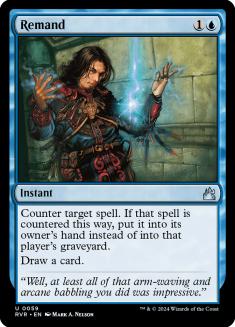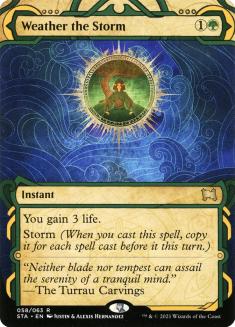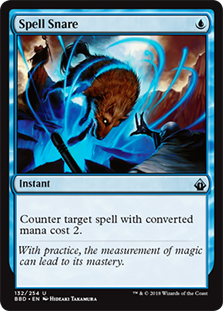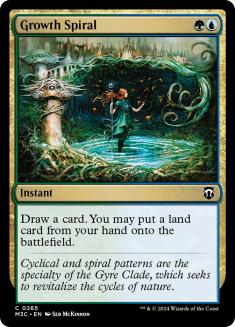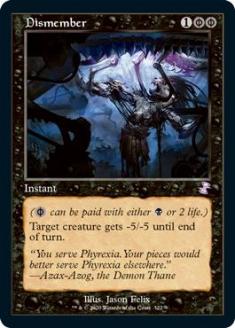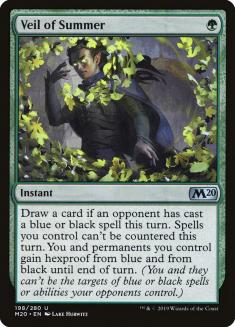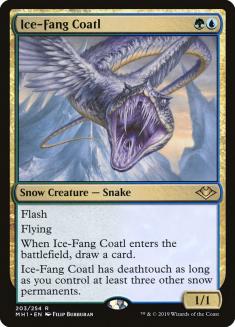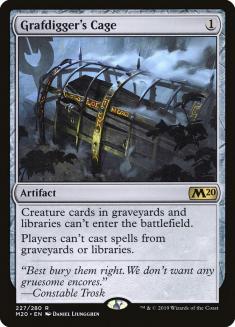Prior to the pandemic, my plan was to play this deck at a Modern MagicFest in March:
Creatures (14)
Lands (28)
Spells (18)
Sideboard

While a lot has changed since then, my confidence in Dryad of the Ilysian Grove in Modern has not. That said, let’s push this aside for a moment to talk about how we got here and the context of Modern as a whole, starting with the former.
Gerry Thompson wrote a piece a while back outlining some more “fair applications” for Dryad. I’ve always had a love for the old-school Prismatic Omen control decks, so I was inspired to mess around. Naturally, I started by making the deck as greedy as possible:
Creatures (12)
Planeswalkers (5)
Lands (27)
Spells (16)

Just for clarity’s sake: the goal here is to assemble Valakut, the Molten Pinnacle and Dryad of the Ilysian Grove. Once you play a sixth land, any land drop from there (including the front half of a fetchland) is worth a Lightning Bolt.
This worked well as a proof of concept, but clearly was working in some pretty extreme directions — I don’t really know what possessed me to include two copies of Field of Ruin. Despite some obvious flaws, going “manual mode” with Dryad of the Ilysian Grove and Valakut is just flat-out powerful. Being able to develop your battlefield early with an extra land drop is a huge boon over Prismatic Omen despite the increased vulnerability, and while it may not look it on paper, this deck kills quickly, especially if you’re able to keep a fetchland or two around before assembling your combo. While not built best to exploit it at this stage, it gets comical when two Valakuts are involved — a game can be “close” to having an opponent dead from eighteen life at the drop of a few triggers.
A few slights aside, there’s probably something to the spirit of this deck. While Wrenn and Six is naturally powerful in any deck that cares about assembling a bunch of lands, it is not worth the cost incurred on your manabase. We’ll come back here when we start talking about various Yorion, Sky Nomad applications.
For now, if you want to really get a feel for the interaction or package that you’re trying to push, put them in a shell ramped up to the maximum that will support what you’re doing. I wanted to essentially build a control deck that could kill quickly with the combination, and otherwise just be playing a stack of strong cards. The goal isn’t always to reinvent the wheel. Wrenn and Teferi, Time Raveler both naturally support this (with Teferi providing protection), greed be damned.
Anyway, back to March. Dryad + Valakut is strong, but clearly I’m asking a bit too much out of my deck.
A lot of strategies using a shell of Archmage’s Charm, Cryptic Command, Mystic Sanctuary, and Uro, Titan of Nature’s Wrath are beginning to pop up and become tuned. While they look fairly strong, they are extremely hard control decks (although some lists are incorporating Stoneforge Mystic), which is a difficult place to be in Modern. No matter how tight your stranglehold of “up two cards with counterspell backup” might be, it is incredibly difficult to translate these short-term advantages into a win against all the linears that Modern has to offer.
Fortunately, I had a victory condition. The internet had provided a shell.
As I got closer and closer to a “stock shell” trying light splashes for Path to Exile + Teferi or utilizing the natural Valakuts for Lightning Bolts and Wrenn and Sixes, I kept noticing a pattern. Archmage’s Charm (in tandem with Sanctuary and Cryptic Command) was overperforming in games where I wasn’t under extreme pressure and could naturally accrue resources and play a normalized game. My dedicated interaction (aka my splash colors) was underperforming — either lining up poorly by matchup or simply prolonging games that I should have the ability to close.
At this point I fully committed to the combo-control deck:
Creatures (10)
Lands (27)
Spells (23)

This list was extremely close, but it had two glaring problems. I’d underestimated how much equity I’d given up against Death’s Shadow and Tarmogoyf by giving up on spot removal and Ice-Fang Coatl. This was an easy fix, as Opt isn’t head-and-shoulders stronger than Coatl as a velocity card to begin with and having a body to pressure planeswalkers is meaningful. The second issue was that, despite having six “combo enablers” for Scapeshift, it was still too detrimental to draw it without one, particularly when under pressure. That wasn’t that difficult a problem either, honestly — I just added a Field of the Dead.
Matchups like Eldrazi Tron got substantially easier, and the deck is already well-suited to closing with just a couple of Zombies due to its control elements and ability to race with Cryptic Command. The deck felt complete.
Hopefully this slightly long winded history of my thought process on how to get to a deck I thought (and still think) is tournament-viable is useful to you while building your own decks.
To recap:
1. Start with an idea or interaction
2. Push it as hard as possible
3. Iterate
4. Hone in on the strongest parts of the idea or interaction
5. Put those into a viable shell
6. Reiterate
So, Ikoria...
Lurrus of the Dream-Den is a huge part of Modern now. There are some direct and indirect implications here. The most glaring is that Burn has gotten both stronger and more popular. Everyone should be more prepared to play against it, and cards that hedge against Burn but are strong in other matchups are premium.
As for the format as a whole, it’s gotten leaner and slowed down a bit. Lurrus + Mishra’s Bauble isn’t pushing the direction of the game as quickly as Liliana of the Veil did. To be clear, this isn’t a judgment of strength; it’s simply different and changes the way the games play out.
For the most part, this plays well into Simic Dryad Shift. We’re good at playing a long game and would generally rather have our opponents develop their resources instead of interacting with ours, but simultaneously the way we win the game doesn’t have anything to do with raw cards.
The other big player worth noting is that another form of Scapeshift is starting to pop up and do well:
Creatures (10)
Lands (36)
Spells (34)

The obvious question is, of course, “Why would I play your deck over this?”
While on some level this deck might appear to be a hybridization of a Yorion midrange deck and a Scapeshift combo deck, there are few ways to translate the cards generating from looping Abundant Growth and Arcum’s Astrolabe into a win outside of casting Scapeshift (assuming that Uro isn’t enough to get it done). Further, while the above decklist is more directly a one-card combo deck, the cost incurred by playing a bunch of Mountains and lands that enter the battlefield tapped is quite high, especially if Burn is more prominent.
Are these meant to be an indictment of this proven strategy or a blind defense of a deck I built? Neither.
Yorion is clearly proven to be strong in Modern, and accruing resources is important when assembling Scapeshift due to the number of lands necessary on the battlefield before you can effectively cast it. There’s a lot to learn here and it’s difficult to say which is stronger. What I do know is that I would want to incorporate Dryad of the Ilysian Grove into any Valakut deck.
With the information that I have now, I’d still suggest Simic Dryad Shift, with a few tweaks.
Creatures (15)
Lands (28)
Spells (17)

VS Lurrus Boros Burn
Out:
In:
This is simple enough. Get lean, interact a little bit, and assemble Dryad + Valakut or escape an Uro. I’m fairly confident that the movement to a third Uro gives us enough ways to close out games that we can go fairly light on win conditions here.
VS Lurrus Jund Midrange
Out (on the play):
In (on the play):
Out (on the draw):
In (on the draw):
This is another good example of the strength of this variant of Scapeshift. Being able to remove the “namesake” card against decks attacking your resources allows you to play longer games more comfortably. I’ve always struggled with the decision of Veil of Summer on the draw, but ultimately have concluded that it’s just too weak on balance. It can still be devastating, but is often too weak on the draw when an opponent can see it with a Turn 1 discard spell and then play around it for the rest of the game.
That said, it might still be worth considering a copy or two if Abrupt Decay continues to be played in large numbers.
Out:
In:
VS Bant SnowBlade
Out:
In:
Remaining flexible is key here. Ice-Fang Coatl’s value drops a bit but consider sideboarding more back in if your opponent looks reliant on Stoneforge Mystic to kill you. Further, if your opponent is heavy on Veils and Mystical Disputes, consider shaving harder on Cryptic Command and embrace being more of a combo deck rather than trying to go toe-to-toe with blue cards.
VS Mono-Green Tron
Out:
In:
Not too many tools here. You could also consider bringing in Tireless Tracker to give more potential closing speed. This matchup is difficult on the draw, but if you can steal a game, you should be in good shape.
VS Eldrazi Tron
Out:
In:
Having no small creatures and frequently turning off your ability to counter their spells results in one of the few matchups where Archmage’s Charm is weak. Thankfully, this matchup is still quite good. Tireless Tracker can yet again be another consideration (shaving more countermagic).
VS Devoted Devastation
Out:
In:
While we’re going quite low on win conditions here, their deck isn’t terribly threatening if you can keep their combo under check. The biggest advantage they have is raw speed, hence several one-mana cards to interact.
In closing, let’s take a crack at Yorion in the spirit of Simic Dryad Shift:
Creatures (11)
Planeswalkers (4)
Lands (36)
Spells (30)

At a glance this looks pretty strong to me. The additional room in our deck plus the natural grinding capabilities of Yorion wants me to play more interaction — a different conclusion from what I’d made with a 60-card deck.
The Wargate / Bring to Light package can shore up any number of finding Dryad, Valakut, or Field of the Dead, and in the latter case kill your opponent or sweep the battlefield. In any case, this represents a lot of the Magic I like to play, and hopefully it gets some other wheels turning.
Who knows? Maybe this is the right way to build Bant Control in Modern.



